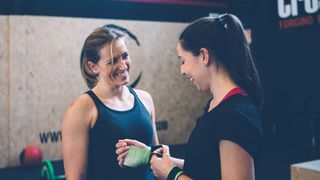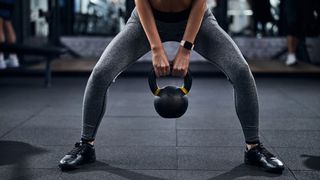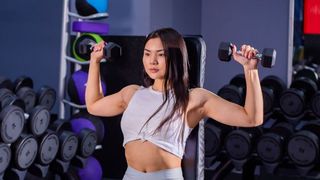The Best Gym Exercises For Women
Hitting the gym? These are the exercises every woman should include in their training

Fail to prepare, prepare to fail, as the saying goes – and anyone who has turned up to the gym without at least a vague workout plan will know how a lack of structure can derail your session. Because your training time is precious, we’ve done the preparatory work for you and selected some of the best gym exercises for women.
We’re not, of course, saying women can’t do the same exercises as men. They absolutely can (and should), but there are a few physiological differences to take into account and which influenced this exercise selection. Firstly, women have a larger lumbar (lower-back) curve, meaning a strong core and hips are essential to maintain correct posture and prevent lower-back pain.
Women also tend to be more quad-dominant than men, with their quadriceps muscles being almost twice as strong as their hamstrings. This imbalance can lead to knee injuries, so hammies should be a central plank of training.
Finally, women with larger chests, and expectant and recent mothers will be no strangers to back, shoulder and neck pain. The solution? Plenty of upper-body strengthening exercises.
So when deciding which exercises to do in your next session, pick a couple from this helpful cheat sheet.
Dead bug

Forget crunches – this move engages the deep, stabilising muscles of your core, as well as your lower back and hips, and teaches you to keep your trunk fixed while moving the rest of your body. Master it and you’ll see improvements in everything from your deadlift form to your running technique.
Lie on your back with your arms extended towards the ceiling. Lift your legs and bend your knees at 90°. Activate your core, drawing your bellybutton towards your spine and pressing your lower back into the floor. Exhale as you slowly lower your right arm behind your head and extend your left leg at the same time until both limbs are just above the floor. Keeping your back in contact with the floor, inhale and slowly return to the starting position. Repeat with the opposite arm and leg.
Get the Coach Newsletter
Sign up for workout ideas, training advice, reviews of the latest gear and more.
Clamshell

Homing in on the often overlooked gluteus medius (the outside edge of your bum and side of your hip), clamshells are a great way to activate your glutes at the start of a session, but the benefits go way beyond a wake-up call for your behind. A strong gluteus medius means powerful and stable hips, which are essential for everything from walking and squatting to preventing knee and back pain. For more of a challenge, slip a resistance band around your thighs.
Lie on your side with your feet and hips stacked, your knees bent at 90° and your head resting on your arm. Make sure your shoulders, hips and feet are in line. Keeping your feet together, raise your top knee as far as you can without rotating your hip or lifting your right knee off the floor. Hold for a second while squeezing your glutes, then slowly lower your knee back to the starting position.
Sumo squat

Assuming standard squats are a fixture of your workouts (which they should be), mix things up with this variation. The sumo targets all the usual suspects (quads, glutes, hip flexors) but hits slightly differently by working your inner thighs and hamstrings a little more. The shift in foot position also throws your balance off, meaning your core has to work extra hard to keep you stable. Start with just your bodyweight, then take it up a level with dumbbells, kettlebells or a barbell.
Stand with your feet slightly wider than hip-width apart and turn your feet out, opening your hips. Inhale while you lower, pushing your hips back, and keeping your back straight and your upper body lifted. Exhale and push through your heels, engaging your inner thighs as you come back to your starting position.
See related :
- Hit The Gym With Confidence Using This Beginner Workout Plan For Women
- Strength Training For Women: A Beginner’s Home Workout Plan
- Krissy Cela’s Abs Workout
- The Best Leg Workout To Do At Home From The Lead PT Of Women’s Workout App SHREDDY
Bent-over row

Anyone whose posture needs work is advised to add bent-over rows into their workouts – and there are side benefits for your biceps, shoulders, forearms and core.
Hold either two dumbbells or a barbell in front of your thighs with your feet shoulder-width apart. Bend your knees and hinge forwards from the hips, keeping your back straight and your neck in line with your spine. Let the weights hang down with your arms extended. Exhale, brace your core and squeeze your shoulders together as you row the weight up. Pause for a second at the top of the movement, then slowly lower. Keep your elbows close to your body and aim to bring the weights towards your hips, not your armpits.
Single-leg deadlift

Deadlifts are a great way to fire up underworked hamstrings, but performing the move on one leg challenges your ability to balance, ups core and glute recruitment, and addresses any imbalances in your body.
Stand with your feet hip-width apart. Hold a kettlebell, a barbell or two dumbbells in your hands in front of you. Lean forwards from your hips, shifting your weight on to one leg while your other leg moves behind you. Hinge at the waist and tip your torso forwards until it’s almost parallel to the floor, letting your rear leg rise behind you to aid your balance. Your arms should be hanging straight down, holding the weights. Keep a slight bend in your standing leg. Slowly bring your rear leg back and raise your torso to return to the start. Do all your reps on one side, then switch.
Dumbbell overhead press

You should consider the overhead press an upper-body workout essential – it helps with everything from counteracting rounded shoulders from hunching over a screen, to everyday tasks like lifting a toddler. We’ve focused on dumbbells, but you can easily sub in a barbell or kettlebell. Just don’t go too heavy – shoulders don’t need a lot of stimulus and fatigue easily.
Stand upright with a straight back. Hold a dumbbell in each hand at shoulder height with an overhand grip – your knuckles should be facing the ceiling. Exhale and push the weights above your head with a controlled movement, being careful not to arch your back. Pause at the top of the move, then lower the dumbbells to shoulder height while you inhale.
Gemma Yates is a journalist and qualified personal trainer. She was formerly acting fitness and beauty editor at the UK edition of Women’s Health.
